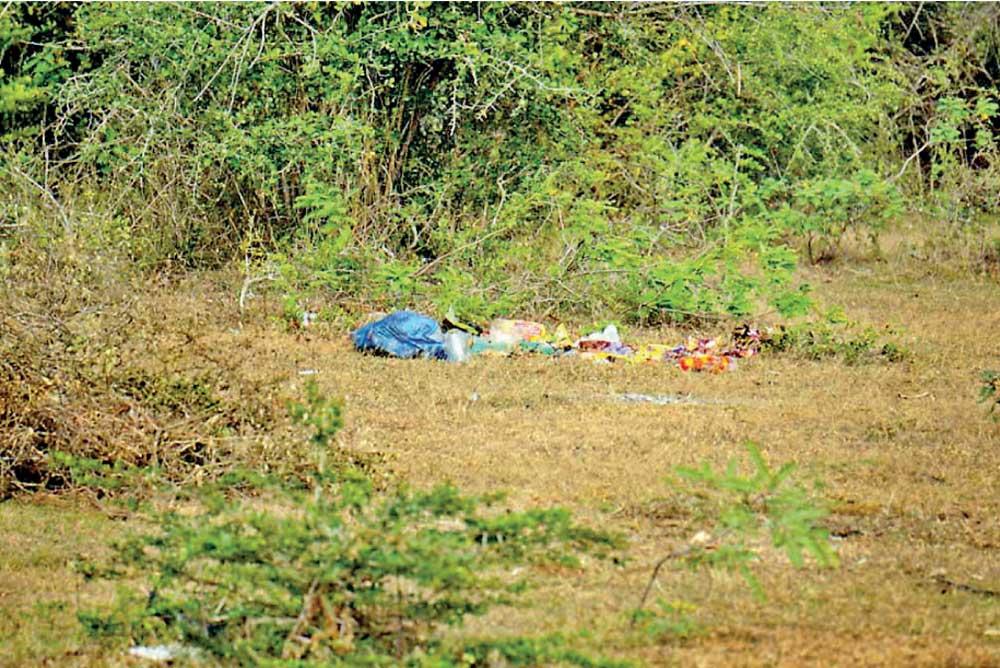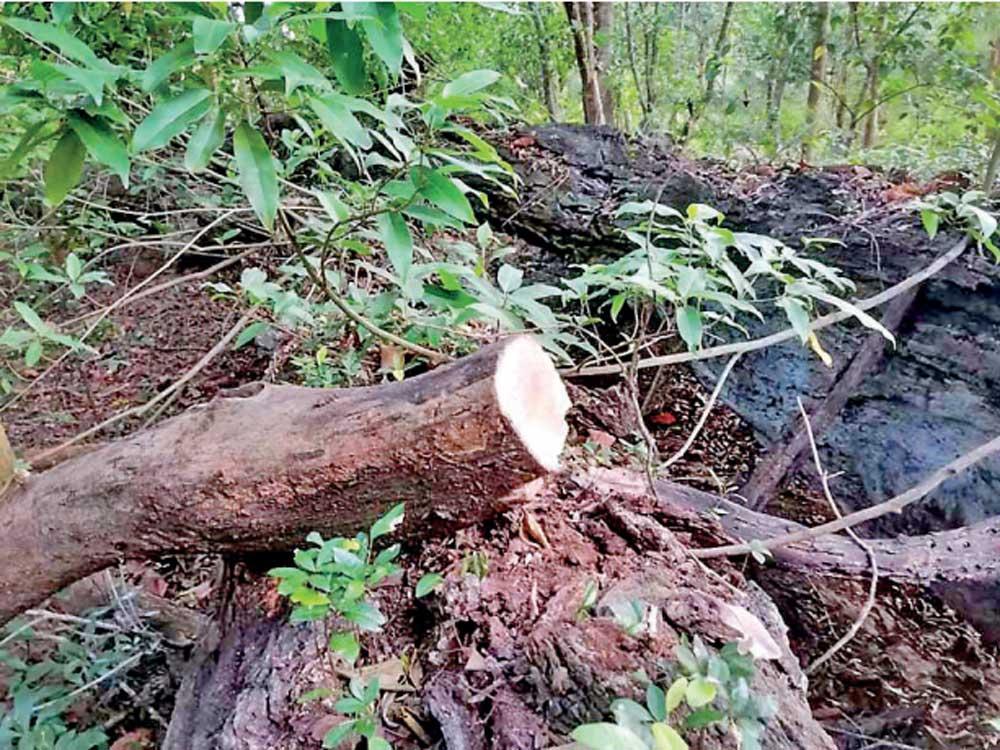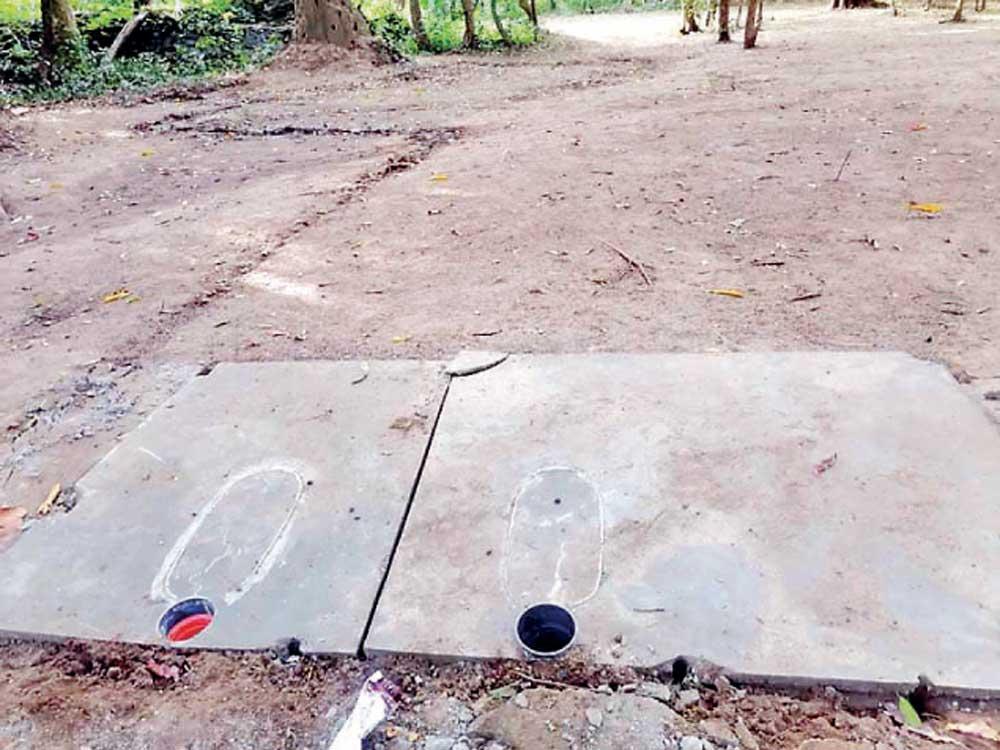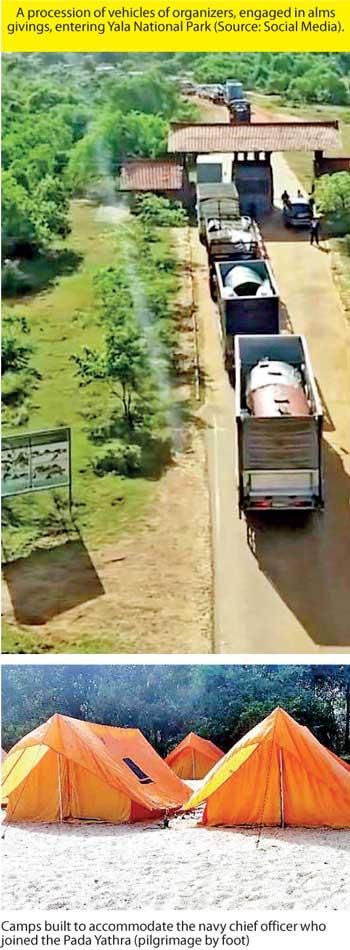Reply To:
Name - Reply Comment

Garbage piled up in the park

Trees are seen cut down in areas where camps were built
Remaining concrete slabs of a construction, meant to serve as a toilet for the chief officer A site, used for alms givings, spreads over a large area within the national park
A site, used for alms givings, spreads over a large area within the national park
 Regulations are necessary to prevent the loss of religious and cultural values associated with the ‘Pada Yatra’ (Pilgrimage by foot) to Kataragama and to safeguard Yala and Kumana national parks from destruction.
Regulations are necessary to prevent the loss of religious and cultural values associated with the ‘Pada Yatra’ (Pilgrimage by foot) to Kataragama and to safeguard Yala and Kumana national parks from destruction.
 The ‘Pada Yatra’ to Kataragama, undertaken by Hindu devotees from Jaffna to the Kataragama Devalaya (Shrine), has been a part of tradition since ancient times. The roots of this tradition run deep into the Hindu religion and its cultural values. However, it is unfortunate that this longstanding pilgrimage has posed a significant threat to the existence of Yala and Kumana National Parks. This is because the pilgrimage has moved away from its original religious and cultural identity.
The ‘Pada Yatra’ to Kataragama, undertaken by Hindu devotees from Jaffna to the Kataragama Devalaya (Shrine), has been a part of tradition since ancient times. The roots of this tradition run deep into the Hindu religion and its cultural values. However, it is unfortunate that this longstanding pilgrimage has posed a significant threat to the existence of Yala and Kumana National Parks. This is because the pilgrimage has moved away from its original religious and cultural identity.
This journey offers an extremely rare opportunity to travel through Sri Lanka’s National Parks for free; otherwise patrons entering the part have to purchase a ticket. Additionally, special approval from the Director General of Wildlife is required to enter Kumana National Park and make ones exit from Yala National Park. There are also specific conditions for travelling within Block 2 of Yala National Park. Therefore, various individuals have been tempted to be part of this journey, because when they do there is no need to meet official requirements and obtaining of permission. These individuals are then able to fulfill narrow needs. This questionable group includes so-called environmentalists, wildlife photographers and adventure travelers. Hence the religious and cultural values of the Kataragama Pada Yatra have been lost and the wildlife reserves are at the brink of destruction. Furthermore, a very serious situation has arisen with some sections of the security forces, Dansal organizers and various government institutions exploiting this loophole to enter Yala and Kumana; thus violating the Fauna and Flora Protection Ordinance.
This year, the gate of Kumana National Park was opened on June 30 to allow people from all over the island to participate in the Pada Yatra. It was closed again on July 12 at four in the evening. Since the conclusion of the war, between 25,000 and 30,000 people have participated in this pilgrimage annually. And this time around the number of pilgrims has increased to a record 32,000. Hindu devotees come to Kataragama with immense devotion to God and enduring great hardships by taking part in the Pada Yatra. The simple forms of worship they practised caused minimal damage to the environment.
During the war, the Army took measures to count the number of pilgrims; citing the risk of LTTE terrorists travelling south via this route. Even after the war ended, the security forces continued to sell water and food to pilgrims; thereby affecting the traditional customs of the pilgrimage. This situation also led to a significant increase in the number of pilgrims. True devotees aspire to complete this pilgrimage, packing everything they need while enduring hardships to demonstrate their piety before God. There is no need to provide them with bottled water or food, let alone health facilities, while they travel through the national parks. However, the so-called environmentalists, wildlife photographers and adventure travelers mentioned earlier require these facilities. Many argue that individuals engaged in irregularities within government institutions support this. Consequently, what should be a genuine, simple pilgrimage has been distorted and this greatly impacts the environment.
Intervention of the navy
 There are many natural water sources for pilgrims from the entrance to the Kumana National Park. Additionally, the Army has been providing free water through bowsers (in addition to selling bottled water) for many years. Despite this, the Navy entered the park during the pilgrimage season, stating plans to install a reverse osmosis plant at Lin Thuna area in the park for pilgrims. Following this, a large contingent of troops entered Yala National Park, to offer protection and services to a chief officer as he too joined the journey. And this group engaged in activities detrimental to the park. These activities included continuous vehicular traffic and forest destruction and they were the results of work being done to build facilities like toilets and latrines at various locations. There was unauthorised travel taking place through other parts of the park outside the designated pilgrimage route.
There are many natural water sources for pilgrims from the entrance to the Kumana National Park. Additionally, the Army has been providing free water through bowsers (in addition to selling bottled water) for many years. Despite this, the Navy entered the park during the pilgrimage season, stating plans to install a reverse osmosis plant at Lin Thuna area in the park for pilgrims. Following this, a large contingent of troops entered Yala National Park, to offer protection and services to a chief officer as he too joined the journey. And this group engaged in activities detrimental to the park. These activities included continuous vehicular traffic and forest destruction and they were the results of work being done to build facilities like toilets and latrines at various locations. There was unauthorised travel taking place through other parts of the park outside the designated pilgrimage route.
The Department of Wildlife Conservation (DWC) prevented vehicles from entering Yala National Park before the due time via the Palatupana entrance; despite encountering pressure. However, Navy vehicles arriving there early in the morning and waiting until the due time obviously enter the park first. As the convoy proceeds through the forest, it inevitably disturbs the captivating wildlife including elephants, leopards and bears; causing them to flee. As a result, both local and foreign tourists, who have travelled long distances, stayed in hotels in the Tissamaharama area and entered the park early in the morning with hopes of seeing animals, ultimately end up disappointed. They then return to their hotels without wildlife sightings they anticipated. It has also been reported that the chief officer of Naval Forces, who joined the pilgrimage with a contingent of 60-70 military personnel who provided him with protection, disregarded the path designated for pilgrims last year. He and his contingent this year entered the path mapped for tourists at Yala National Park from Thalgasmankada area and behaved in an arbitrary manner. This situation is unfavourable for both wildlife and the tourism industry.
Influence of organizers of alms giving
During this season, representatives of various public and private sectors, as well as individuals, including representatives from the Sri Dalada Maligawa (Temple of the Tooth), enter the protected area to organise alms givings. This includes those so-called environmentalists, wildlife photographers and individuals claiming to conduct health camps. They are accused of roaming around in their Defender vehicles, flashing strong beams of light that disturb wildlife at night. Such activities are detrimental to wildlife conservation.
Even tourists who enter a national park after purchasing the relevant ticket and obtaining proper permits are restricted from travelling within the park between 6 am and 6 pm. However, it is unacceptable that the aforementioned parties enter the park during this pilgrimage season under various pretexts and exploit the permission granted by the DWC in violation of conservation laws. Specifically, there are allegations that organizers of alma givings from Dalada Maligawa, who book the Parana Thotupala tourist bungalow in Yala Block 1, use the alms givings as a pretext to travel both day and night from Parana Thotupala to Pilinnawa (and beyond) in Block 2, where they organise alms givings. Additionally, a significant number of individuals has reportedly entered the park claiming to conduct rice and chickpea alms givings in the Lin Thuna and Kebellewela areas of Block 2 without restraint.
Even after the end of the war, pilgrims participated in the pilgrimage by foot for many years without relying alms from anyone. The photos and videos posted by these parties on social media make it evident whether these outsiders entered Yala out of compassion for the pilgrims or merely for their own entertainment. It is worth noting that some organizers of alms givings arrived with luxurious caravans to support the journey; during which participants traditionally walk for miles, prepare simple meals, and camp overnight in open fields.
With a few exceptions, tourists entering the national parks of Sri Lanka are required to be accompanied by a tour guide provided by the DWC. Alternatively, they should be accompanied by safari jeep drivers, who are accountable to the department (with exceptions possible). However, for nearly a fortnight, tens of thousands of outsiders have been freely roaming in Blocks One and Two of Kumana and Yala National Parks without following any such guides. Therefore, it is crucial for the DWC to closely monitor these situations. In this context, as mentioned earlier, the use of Defender vehicles for roaming and disturbing wildlife with high-powered lights openly even at night, along with activities like filming with drone cameras, indicate a lack of effective monitoring.
In this manner, the prolonged presence of a large number of people in wildlife reserves leads to various environmental effects, such as disrupting natural behaviour patterns of wildlife and polluting natural ecosystems and water sources with sewage and waste. As the number of tourists increases, so does the impact. The transformation of the ‘Kataragama Pada Yatra’ from a rigorous pilgrimage to a festival is expected to further increase tourist numbers and escalate the environmental impacts. Therefore, it is crucial that all levels of management within the DWC, from the Director General of Wildlife to the wardens of Yala and Kumana National Parks, pay more attention when granting relevant approvals. It is also the responsibility of the government to allocate wildlife conservation officers and essential infrastructure to closely monitor human activities and resulting situations, and to implement necessary urgent measures without hesitation. Critics want to emphasise that governors, religious leaders, and representatives of all public and private sectors have a duty towards ensuring that this ancient pilgrimage is not exploited for short-term entertainment, and that government funds are not wasted on related fraudulent activities. Responsible actions must be taken to safeguard wildlife and prevent the misuse of this opportunity to bypass environmental regulations.